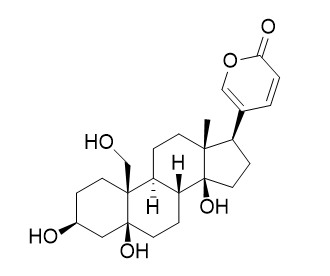Hellebrigenol
Hellebrigenol shows cytotoxicity against HepG2 cells.
Inquire / Order:
manager@chemfaces.com
Technical Inquiries:
service@chemfaces.com
Tel:
+86-27-84237783
Fax:
+86-27-84254680
Address:
1 Building, No. 83, CheCheng Rd., Wuhan Economic and Technological Development Zone, Wuhan, Hubei 430056, PRC
Providing storage is as stated on the product vial and the vial is kept tightly sealed, the product can be stored for up to
24 months(2-8C).
Wherever possible, you should prepare and use solutions on the same day. However, if you need to make up stock solutions in advance, we recommend that you store the solution as aliquots in tightly sealed vials at -20C. Generally, these will be useable for up to two weeks. Before use, and prior to opening the vial we recommend that you allow your product to equilibrate to room temperature for at least 1 hour.
Need more advice on solubility, usage and handling? Please email to: service@chemfaces.com
The packaging of the product may have turned upside down during transportation, resulting in the natural compounds adhering to the neck or cap of the vial. take the vial out of its packaging and gently shake to let the compounds fall to the bottom of the vial. for liquid products, centrifuge at 200-500 RPM to gather the liquid at the bottom of the vial. try to avoid loss or contamination during handling.
J Agric Food Chem.2020, 68(43):12164-12172.
Food Funct.2024, 15(4):1852-1866.
Pharmaceuticals (Basel).2024, 17(10):1368.
Appl Biochem Biotechnol.2020, 190(2):732-744
Tokyo Pharmaceutical University2020, 500001431953.
J Enzyme Inhib Med Chem.2019, 34(1):134-143
Nat Prod Commun.2018, 10.1177
Food Science and Human Wellness2022, 11(4):965-974
J Microbiol Biotechnol.2023, 33(10):1317-1328.
Food Chem.2024, 446:138870.
Related and Featured Products
Anal Bioanal Chem. 2016 Apr;408(10):2485-95.
Metabolites profiling of 10 bufadienolides in human liver microsomes and their cytotoxicity variation in HepG2 cell.[Pubmed:
26869342 ]
Bufadienolides, a class of polyhydroxy steroids, exhibit significant antitumor activity.
METHODS AND RESULTS:
In this study, a total of 39 metabolites from 10 bufadienolides were detected and identified by ultrahigh-performance liquid chromatography (UHPLC) coupled with an LTQ Orbitrap mass spectrometer. The results showed that hydroxylation and dehydrogenation were the major metabolic pathways of bufadienolides in human liver microsomes (HLMs). CYP3A4 was found to be the major metabolic enzyme and CYP2D6 only mediated the dehydrogenation reaction. A systematic validated cytotoxicity evaluation method for bufadienolide metabolites at equal equivalents was established. Hellebrigenin (1), Hellebrigenol (2), arenobufagin (3), bufotalin (5), and bufalin (6) were selected to determine their cytotoxicity against HepG2 cells before and after incubation in HLMs. All the test samples were enriched by a validated solid-phase extraction (SPE) method.
CONCLUSIONS:
Although the cytotoxicities of metabolites were weaker than those of the parent compounds to different degrees, their effects were still strong.
Zhongguo Zhong Yao Za Zhi. 2014 Mar;39(5):841-5.
Bufadienolides from venom of Bufo bufo gargarizans.[Pubmed:
25204176]
Twelve compounds were isolated from the venom of Bufo bufo gargarizans.
METHODS AND RESULTS:
On the basis of their physical and chemical properties and spectral data, their structures were identified as resibufagenin (1), bufotalin (2), desacetylcinobufagin (3), 19-oxodesacetylcinobufotalin (4), cinobufotalin (5), 1beta-hydroxylbufalin (6), 12alpha-hydroxybufalin (7), bufotalinin (8), Hellebrigenin (9), telocinobufagin (10), Hellebrigenol (11) and cinobufagin-3-hemisuberate methyl ester (12), respectively.
CONCLUSIONS:
Compounds 7 and 12 are new natural products.



